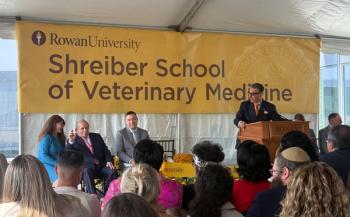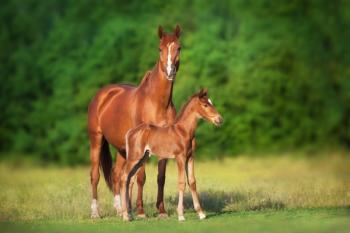
A strong veterinarian-farrier relationship is just plain horse sense
Collaborative partnerships between equine veterinarians and farriers support healthier hooves and horses.
Sam Zalesky, CJF, and Josh Wilbers, APF, of Rood and Riddle Equine Hospital. (All images courtesy of Dr. Raul Bras.)A strong veterinarian-farrier relationship is a crucial component in keeping horses healthy-especially thoroughbred racehorses, due to their propensity to foot-related lameness-says Raul J. Bras, DVM, CJF, APF. For centuries, the farrier and the veterinarian were the same person-someone who would take the initiative in dealing with hoof problems. Now that the two professions are separate, tension and conflict often occur along the fuzzy boundaries of the two roles as they figure out how to work together. When both professions understand, respect and integrate the knowledge and expertise offered by the other, everyone-especially the horse-benefits.
When farriers and veterinarians step on each other's hooves
Dr. Bras, who works in the podiatry department at Rood and Riddle Equine Hospital in Lexington, Kentucky, understands the importance of the collaboration between the farrier and the veterinarian. (He happens to be highly skilled in both professions.)
A veterinarian and a farrier working harmoniously together on a case.“When there is a foot-related problem, you need both the veterinarian and the farrier to work in concert for the benefit the horse,” says Dr. Bras. “The perfect case is when the farrier becomes the veterinarian's best ally-when the two have an understanding of and respect for each other's expertise. The veterinarian provides medical knowledge and experience, while the farrier brings his practical knowledge and mechanical skills, such as hoof-shaping, shoeing and even therapeutic shoeing.”
However, this important relationship is conflict-prone, usually when a farrier attempts to assume the duties of a veterinarian and vice versa, says Dr. Bras. Horse owners can inadvertently exacerbate the situation with comments like, “Well, that's what the veterinarian told me,” to the farrier and, “That's what I was told by the farrier,” to the veterinarian, creating opposing sides.
Reining in conflict: Know your role
The first step in building better veterinarian-farrier relationships is for each profession to have a thorough understanding of the skills and expertise the other possesses.
“We still lack equine podiatry within the veterinary school education curriculum in many institutions,” Dr. Bras says. “Many equine practitioners graduate veterinary school and then try to assume the farrier's role, despite lacking many of the practical skills of farriery.”
Hoof maintenance
An adult hoof grows about 0.38 inches per month, depending on season, exercise, metabolic rate and genetics. For horses on pasture, hooves need to be trimmed and reshod every six to eight weeks. For dirt-racing thoroughbreds, this needs to occur every three to four weeks.
The farrier is the best person to ensure good shoe, good foot-as per the adage “No hoof, no horse.” When farriers work on horses without foot issues, they are the professionals, says Dr. Bras. A skilled farrier's various duties include selecting proper shoes for horses and providing regular hoof care and maintenance. Farriers also replace worn shoes and provide therapeutic trimming and shoeing when necessary. (How often this occurs varies from horse to horse. See “Hoof maintenance,” at right, for more information.)
Because thoroughbred racehorses are essentially always shod, various problems such as contracted heels, underrun heels, hoof wall separation under the shoe and elongated toes can occur. Though farriers take the lead on these issues, it's critically important that they collaborate with veterinarians when lameness occurs.
Dr. Raul Bras shoeing a horse.Reining in conflict: Bridle your tongue
Another key in preventing conflict is to foster clear, open communication between the two professionals. Farriers and veterinarians should communicate directly with each other (preferably face to face), and they should seek each other's opinions before deciding on a course of action.
Whether a horse develops a foot problem because of injury, illness, poor genetics or unbalanced shoeing, the farrier and veterinarian should develop a therapeutic shoeing plan in concert. This is especially necessary when treating horses with debilitating and even life-threatening hoof aliments. Both professionals should also be sensitive to the jargon they're using and strive to communicate using shared terminology.
Gallop into a better future
“Advancement of farriery has come a really long way, and during recent years, farriers have been able to take advantage of continuing education,” says Dr. Bras.
Similarly, veterinarians are experiencing an increased focus on equine foot care at conferences and in veterinary school. And as long as the two professions continue to move toward collaboration while improving themselves individually, equine care will improve as well.
“The horse is in a better place when both the farrier and veterinarian work in harmony,” says Dr. Bras.
Ed Kane, PhD, is a researcher and consultant in animal nutrition. He is an author and editor on nutrition, physiology and veterinary medicine with a background in horses, pets and livestock.
Newsletter
From exam room tips to practice management insights, get trusted veterinary news delivered straight to your inbox—subscribe to dvm360.






